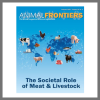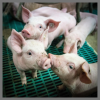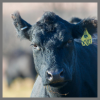-

Apr
17
Interpretive Summary: Influence of heat stress and fescue toxicosis on the pulmonary arterial pressure of beef heifers

The ergot alkaloids produced by endophyte-infected (EI) varieties of tall fescue are beneficial to the plant but detrimental to cattle, as they induce different negative responses that are commonly referred to as fescue toxicosis (FT). The increased ambient temperature and humidity commonly experienced during the summer aggravate the symptoms of FT and this interaction significantly reduces animal performance and productivity.
Read more
-

Apr
17
Interpretive Summary: Out of Africa: genetic characterization and diversity of Mashona cattle in the United States

The Mashona cattle, a Bos taurus and Bos indicus composite, were brought from Zimbabwe to New Mexico in the 1990s. Since then, they have been valued by ranchers in hot and humid areas for their resistance to pests, heat, and maternal characteristics, making them ideal for crossbreeding. This study aimed to explore the genetic background and diversity of Mashona cattle in the United States by analyzing 24 samples from Tennessee State University.
Read more
-

Apr
17
Interpretive Summary: Breed-specific heterosis for growth and carcass traits in 18 U.S. cattle breeds

Heterosis, or hybrid vigor, is traditionally defined as the increase in the performance of crossbred progeny relative to the average performance of their purebred parents. These heterosis effects may vary depending on the breed of animals in the original cross; however, breed-specific estimates are difficult to obtain because of the resources required to estimate the effects. The Germplasm Evaluation Program at the U.S. Meat Animal Research Center is designed to evaluate crosses of 18 different prominent U.S. beef cattle breeds.
Read more
-

Apr
17
Interpretive Summary: The societal role of meat and livestock—what the science says

The Dublin Declaration of Scientists on the Societal Role of Livestock (2023) was initiated during the International Summit on the Societal Role of Meat, held in October 2022 in Dublin. Scientific evidence in support of the declaration was provided through a variety of oral presentations by leading experts and a series of articles published in a previous Themed Issue of Animal Frontiers (Volume 13, Issue 2, April 2023, ISSN 2160-6056, EISSN 2160-6064). Since the declaration was issued for the publishing of this editorial, over 1,200 verified scientists from around the world have signed to document their agreement.
Read more
-

Apr
03
Interpretive Summary: Enteric methane emission classification and ranking of growing steers during the backgrounding and finishing phases

Ruminants present variability in enteric methane (CH4) emissions over time and due to changes in dietary characteristics; however, limited information exists regarding the re-ranking according to CH4 emissions of growing steers during the backgrounding and finishing phases, and the effect of using metabolic modulators such as growth-promoting implants, on gas flux. In this experiment, 46 Angus steers were evaluated during the backgrounding and finishing phases.
Read more
-

Apr
03
Interpretive Summary: Effects of dietary supplementation with linseed oil, Ascophyllum nodosum or treated A. nodosum on animal performance, gaseous emissions, ruminal fermentation and microbiota, and meat quality in growing dairy-beef bulls

Globally there is a requirement to reduce greenhouse gas emissions while increasing food production to meet the nutritional demands of the growing population. In this study, linseed oil, a temperate brown seaweed, or an extract of the brown seaweed were mixed into concentrate feed and offered to growing beef bulls every morning and evening.
Read more
-

Apr
03
Interpretive Summary: Effects of increasing dietary zinc oxide levels on the hepatic mitochondrial energy metabolism, oxidative balance, and antioxidant system in weaned piglets

High dietary levels of zinc oxide (ZnO) have been used in swine production to prevent/control postweaning diarrhea. However, such strategy has been demonstrated to stimulate bacterial resistance to antibiotics and metals.
Read more
-

Apr
03
Interpretive Summary: Effect of Luteolin on cadmium-inhibited bone growth via suppressing osteoclastogenesis in laying chickens

Luteolin (Lut) is a natural flavonoid extract from various plants and exhibits multiple biological activities, including anti-inflammatory, antitumor, antibacterial, and antiviral effects. Importantly, Lut can form metal complexes with trace metal elements, enhancing its resorption and utilization in animals.
Read more
-

Apr
03
Interpretive Summary: Partially replacing dietary starch with soybean oil improved production performance of weaned Rex rabbits

High-starch diets in rabbit farming may pose health risks. Therefore, we focused on fats, another key energy source for monogastric animals, and investigated the effects of replacing part of the dietary starch with fats of equivalent digestible energy.
Read more
-

Apr
03
Interpretive Summary: Prediction of Pellet Durability Index in a commercial feed mill using multiple linear regression with variable selection and dimensionality reduction

Pellet quality is an important determinant of downstream animal performance, as well as efficiency of production both at the mill and farm. Pellet Durability Index (PDI) is a metric used in commercial feed milling to signal the pellet quality of pelleted feeds, and what degradation of pellets might occur during subsequent handling and transportation.
Read more
-

Apr
03
Washington Roundup – March 2025

With a March 14th deadline looming, Congress was able to pass a continuing resolution to fund the government through the remainder of fiscal year 2025. The resolution included mainly “level” funding for programs at their fiscal year 2024 amounts. That was true for USDA’s agricultural research accounts within NIFA, ARS, ERS and NASS. The one exception was the removal of funding in the ARS Buildings and Facilities line for fiscal year 2025.
Read more
-

Mar
20
Interpretive Summary: Development of a prototype genetic evaluation for teat and udder score in American Angus cattle

Estimated breeding values provide an estimate of the genetic merit of an individual for specific traits helping to identify animals with superior genetic potential for growth rate, milk production, meat quality, disease resistance, and more. Over recent years, American Angus Association members have visually scored cows for teat size (TS) and udder suspension score (US), amassing approximately 42,000 records on approximately 24,000 cows.
Read more
-

Mar
20
Interpretive Summary: Genetic parameter estimates of liver abscesses in feedlot beef cattle

Condemned livers result in over $15M in lost income to the U.S. beef industry annually and the main cause of condemned livers is from abscesses. Liver scoring is a four-level measurement of abscess severity: 0 (no abscesses), A− (mild abscesses), A (moderate abscesses), and A+ (severe abscesses).
Read more
-

Mar
20
Interpretive Summary: Genomic analysis of mobility measures on 5-month-old gilts associated with structural soundness

If methods existed to identify gilts that will become lame in breeding herds, then these gilts could be redirected as market animals indirectly improving sow well-being, longevity, and increasing profitability. This study evaluated gilts (age 5 mo) and then observed those retained for breeding throughout their productive life.
Read more
-

Mar
20
Interpretive Summary: Exploring the effects of dietary lysine and tryptophan on the social behavior of pigs

Negative social behaviors between pigs can cause stress, which can compromise welfare. There has been significant interest in exploring the effect of diet on negative social behaviors and the wider social behavior repertoire of pigs. The aim of this study was to determine the effects of dietary lysine and tryptophan levels, 2 amino acids found in pig feed, on the social behavior of commercially housed pigs.
Read more
-

Mar
20
Interpretive Summary: In vitro fermentation characteristics of dietary fibers using fecal inoculum from dogs consuming commercial or grain kefir

As a fermentable milk drink, kefir may affect gastrointestinal microbiota, but such products are poorly studied in companion animals. Our objective was to determine how commercial or traditional kefir feeding impacted the in vitro fermentation characteristics of fibers common in pet foods.
Read more
-

Mar
19
The Giving Herd - ASAS Foundation Newsletter - March 2025

The March Edition of The Giving Herd, an ASAS Foundation Newsletter
Read more
-

Mar
06
PRESS RELEASE: Society-Owned Animal Science Journals Join Forces to Address Challenges in Scientific Publishing
A group of Editors-in-Chief from leading animal science journals has published a collective perspective on today’s rapidly shifting world of scholarly publishing. Titled “Values Shared by Journals of Learned Societies, Associations, and Scientific Institutions in Animal Science” this jointly authored editorial underscores how society-owned journals preserve scientific integrity, maintain rigorous peer review, and ensure responsible access to research findings—even in an increasingly author-driven environment.
Read more
-

Mar
06
Interpretive Summary: Breed and trace mineral source influence the performance of beef heifers during periods of nutrient restriction and grazing forage at early vegetative stage

This study examined how breed and trace mineral sources affect growth and diarrhea incidence during periods of nutrient restriction and grazing. Breeds consisted of ½ Angus × ½ Nelore (ANE) and Nelore (NE) heifers, whereas mineral sources included sulfate (SUL) or hydroxychloride (HYD) sources of copper, manganese, and zinc offered to heifers from days 0 to 49.
Read more
-

Mar
06
Interpretive Summary: Influence of feeding thermally peroxidized lipids on the performance of growing pigs

Feeding pigs diets with lipids that contain peroxides and aldehydes has been reported to reduce pig performance. Four experiments conducted in growing pigs fed diets containing variable levels of peroxides and aldehydes confirmed that lipid oxidation products have a detrimental effect on pig performance and show that the reduction in daily gain, feed intake, and feed efficiency can be accurately predicted by analyzing dietary concentrations of peroxides and aldehydes.
Read more
 AprInterpretive Summary: Influence of heat stress and fescue toxicosis on the pulmonary arterial pressure of beef heifers
AprInterpretive Summary: Influence of heat stress and fescue toxicosis on the pulmonary arterial pressure of beef heifers The ergot alkaloids produced by endophyte-infected (EI) varieties of tall fescue are beneficial to the plant but detrimental to cattle, as they induce different negative responses that are commonly referred to as fescue toxicosis (FT). The increased ambient temperature and humidity commonly experienced during the summer aggravate the symptoms of FT and this interaction significantly reduces animal performance and productivity.
The ergot alkaloids produced by endophyte-infected (EI) varieties of tall fescue are beneficial to the plant but detrimental to cattle, as they induce different negative responses that are commonly referred to as fescue toxicosis (FT). The increased ambient temperature and humidity commonly experienced during the summer aggravate the symptoms of FT and this interaction significantly reduces animal performance and productivity. AprInterpretive Summary: Out of Africa: genetic characterization and diversity of Mashona cattle in the United States
AprInterpretive Summary: Out of Africa: genetic characterization and diversity of Mashona cattle in the United States The Mashona cattle, a Bos taurus and Bos indicus composite, were brought from Zimbabwe to New Mexico in the 1990s. Since then, they have been valued by ranchers in hot and humid areas for their resistance to pests, heat, and maternal characteristics, making them ideal for crossbreeding. This study aimed to explore the genetic background and diversity of Mashona cattle in the United States by analyzing 24 samples from Tennessee State University.
The Mashona cattle, a Bos taurus and Bos indicus composite, were brought from Zimbabwe to New Mexico in the 1990s. Since then, they have been valued by ranchers in hot and humid areas for their resistance to pests, heat, and maternal characteristics, making them ideal for crossbreeding. This study aimed to explore the genetic background and diversity of Mashona cattle in the United States by analyzing 24 samples from Tennessee State University. AprInterpretive Summary: Breed-specific heterosis for growth and carcass traits in 18 U.S. cattle breeds
AprInterpretive Summary: Breed-specific heterosis for growth and carcass traits in 18 U.S. cattle breeds Heterosis, or hybrid vigor, is traditionally defined as the increase in the performance of crossbred progeny relative to the average performance of their purebred parents. These heterosis effects may vary depending on the breed of animals in the original cross; however, breed-specific estimates are difficult to obtain because of the resources required to estimate the effects. The Germplasm Evaluation Program at the U.S. Meat Animal Research Center is designed to evaluate crosses of 18 different prominent U.S. beef cattle breeds.
Heterosis, or hybrid vigor, is traditionally defined as the increase in the performance of crossbred progeny relative to the average performance of their purebred parents. These heterosis effects may vary depending on the breed of animals in the original cross; however, breed-specific estimates are difficult to obtain because of the resources required to estimate the effects. The Germplasm Evaluation Program at the U.S. Meat Animal Research Center is designed to evaluate crosses of 18 different prominent U.S. beef cattle breeds. AprInterpretive Summary: The societal role of meat and livestock—what the science says
AprInterpretive Summary: The societal role of meat and livestock—what the science says The Dublin Declaration of Scientists on the Societal Role of Livestock (2023) was initiated during the International Summit on the Societal Role of Meat, held in October 2022 in Dublin. Scientific evidence in support of the declaration was provided through a variety of oral presentations by leading experts and a series of articles published in a previous Themed Issue of Animal Frontiers (Volume 13, Issue 2, April 2023, ISSN 2160-6056, EISSN 2160-6064). Since the declaration was issued for the publishing of this editorial, over 1,200 verified scientists from around the world have signed to document their agreement.
The Dublin Declaration of Scientists on the Societal Role of Livestock (2023) was initiated during the International Summit on the Societal Role of Meat, held in October 2022 in Dublin. Scientific evidence in support of the declaration was provided through a variety of oral presentations by leading experts and a series of articles published in a previous Themed Issue of Animal Frontiers (Volume 13, Issue 2, April 2023, ISSN 2160-6056, EISSN 2160-6064). Since the declaration was issued for the publishing of this editorial, over 1,200 verified scientists from around the world have signed to document their agreement. AprInterpretive Summary: Enteric methane emission classification and ranking of growing steers during the backgrounding and finishing phases
AprInterpretive Summary: Enteric methane emission classification and ranking of growing steers during the backgrounding and finishing phases Ruminants present variability in enteric methane (CH4) emissions over time and due to changes in dietary characteristics; however, limited information exists regarding the re-ranking according to CH4 emissions of growing steers during the backgrounding and finishing phases, and the effect of using metabolic modulators such as growth-promoting implants, on gas flux. In this experiment, 46 Angus steers were evaluated during the backgrounding and finishing phases.
Ruminants present variability in enteric methane (CH4) emissions over time and due to changes in dietary characteristics; however, limited information exists regarding the re-ranking according to CH4 emissions of growing steers during the backgrounding and finishing phases, and the effect of using metabolic modulators such as growth-promoting implants, on gas flux. In this experiment, 46 Angus steers were evaluated during the backgrounding and finishing phases. AprInterpretive Summary: Effects of dietary supplementation with linseed oil, Ascophyllum nodosum or treated A. nodosum on animal performance, gaseous emissions, ruminal fermentation and microbiota, and meat quality in growing dairy-beef bulls
AprInterpretive Summary: Effects of dietary supplementation with linseed oil, Ascophyllum nodosum or treated A. nodosum on animal performance, gaseous emissions, ruminal fermentation and microbiota, and meat quality in growing dairy-beef bulls Globally there is a requirement to reduce greenhouse gas emissions while increasing food production to meet the nutritional demands of the growing population. In this study, linseed oil, a temperate brown seaweed, or an extract of the brown seaweed were mixed into concentrate feed and offered to growing beef bulls every morning and evening.
Globally there is a requirement to reduce greenhouse gas emissions while increasing food production to meet the nutritional demands of the growing population. In this study, linseed oil, a temperate brown seaweed, or an extract of the brown seaweed were mixed into concentrate feed and offered to growing beef bulls every morning and evening. AprInterpretive Summary: Effects of increasing dietary zinc oxide levels on the hepatic mitochondrial energy metabolism, oxidative balance, and antioxidant system in weaned piglets
AprInterpretive Summary: Effects of increasing dietary zinc oxide levels on the hepatic mitochondrial energy metabolism, oxidative balance, and antioxidant system in weaned piglets High dietary levels of zinc oxide (ZnO) have been used in swine production to prevent/control postweaning diarrhea. However, such strategy has been demonstrated to stimulate bacterial resistance to antibiotics and metals.
High dietary levels of zinc oxide (ZnO) have been used in swine production to prevent/control postweaning diarrhea. However, such strategy has been demonstrated to stimulate bacterial resistance to antibiotics and metals. AprInterpretive Summary: Effect of Luteolin on cadmium-inhibited bone growth via suppressing osteoclastogenesis in laying chickens
AprInterpretive Summary: Effect of Luteolin on cadmium-inhibited bone growth via suppressing osteoclastogenesis in laying chickens Luteolin (Lut) is a natural flavonoid extract from various plants and exhibits multiple biological activities, including anti-inflammatory, antitumor, antibacterial, and antiviral effects. Importantly, Lut can form metal complexes with trace metal elements, enhancing its resorption and utilization in animals.
Luteolin (Lut) is a natural flavonoid extract from various plants and exhibits multiple biological activities, including anti-inflammatory, antitumor, antibacterial, and antiviral effects. Importantly, Lut can form metal complexes with trace metal elements, enhancing its resorption and utilization in animals. AprInterpretive Summary: Partially replacing dietary starch with soybean oil improved production performance of weaned Rex rabbits
AprInterpretive Summary: Partially replacing dietary starch with soybean oil improved production performance of weaned Rex rabbits High-starch diets in rabbit farming may pose health risks. Therefore, we focused on fats, another key energy source for monogastric animals, and investigated the effects of replacing part of the dietary starch with fats of equivalent digestible energy.
High-starch diets in rabbit farming may pose health risks. Therefore, we focused on fats, another key energy source for monogastric animals, and investigated the effects of replacing part of the dietary starch with fats of equivalent digestible energy. AprInterpretive Summary: Prediction of Pellet Durability Index in a commercial feed mill using multiple linear regression with variable selection and dimensionality reduction
AprInterpretive Summary: Prediction of Pellet Durability Index in a commercial feed mill using multiple linear regression with variable selection and dimensionality reduction Pellet quality is an important determinant of downstream animal performance, as well as efficiency of production both at the mill and farm. Pellet Durability Index (PDI) is a metric used in commercial feed milling to signal the pellet quality of pelleted feeds, and what degradation of pellets might occur during subsequent handling and transportation.
Pellet quality is an important determinant of downstream animal performance, as well as efficiency of production both at the mill and farm. Pellet Durability Index (PDI) is a metric used in commercial feed milling to signal the pellet quality of pelleted feeds, and what degradation of pellets might occur during subsequent handling and transportation. AprWashington Roundup – March 2025
AprWashington Roundup – March 2025 With a March 14th deadline looming, Congress was able to pass a continuing resolution to fund the government through the remainder of fiscal year 2025. The resolution included mainly “level” funding for programs at their fiscal year 2024 amounts. That was true for USDA’s agricultural research accounts within NIFA, ARS, ERS and NASS. The one exception was the removal of funding in the ARS Buildings and Facilities line for fiscal year 2025.
With a March 14th deadline looming, Congress was able to pass a continuing resolution to fund the government through the remainder of fiscal year 2025. The resolution included mainly “level” funding for programs at their fiscal year 2024 amounts. That was true for USDA’s agricultural research accounts within NIFA, ARS, ERS and NASS. The one exception was the removal of funding in the ARS Buildings and Facilities line for fiscal year 2025. MarInterpretive Summary: Development of a prototype genetic evaluation for teat and udder score in American Angus cattle
MarInterpretive Summary: Development of a prototype genetic evaluation for teat and udder score in American Angus cattle Estimated breeding values provide an estimate of the genetic merit of an individual for specific traits helping to identify animals with superior genetic potential for growth rate, milk production, meat quality, disease resistance, and more. Over recent years, American Angus Association members have visually scored cows for teat size (TS) and udder suspension score (US), amassing approximately 42,000 records on approximately 24,000 cows.
Estimated breeding values provide an estimate of the genetic merit of an individual for specific traits helping to identify animals with superior genetic potential for growth rate, milk production, meat quality, disease resistance, and more. Over recent years, American Angus Association members have visually scored cows for teat size (TS) and udder suspension score (US), amassing approximately 42,000 records on approximately 24,000 cows. MarInterpretive Summary: Genetic parameter estimates of liver abscesses in feedlot beef cattle
MarInterpretive Summary: Genetic parameter estimates of liver abscesses in feedlot beef cattle Condemned livers result in over $15M in lost income to the U.S. beef industry annually and the main cause of condemned livers is from abscesses. Liver scoring is a four-level measurement of abscess severity: 0 (no abscesses), A− (mild abscesses), A (moderate abscesses), and A+ (severe abscesses).
Condemned livers result in over $15M in lost income to the U.S. beef industry annually and the main cause of condemned livers is from abscesses. Liver scoring is a four-level measurement of abscess severity: 0 (no abscesses), A− (mild abscesses), A (moderate abscesses), and A+ (severe abscesses). MarInterpretive Summary: Genomic analysis of mobility measures on 5-month-old gilts associated with structural soundness
MarInterpretive Summary: Genomic analysis of mobility measures on 5-month-old gilts associated with structural soundness If methods existed to identify gilts that will become lame in breeding herds, then these gilts could be redirected as market animals indirectly improving sow well-being, longevity, and increasing profitability. This study evaluated gilts (age 5 mo) and then observed those retained for breeding throughout their productive life.
If methods existed to identify gilts that will become lame in breeding herds, then these gilts could be redirected as market animals indirectly improving sow well-being, longevity, and increasing profitability. This study evaluated gilts (age 5 mo) and then observed those retained for breeding throughout their productive life. MarInterpretive Summary: Exploring the effects of dietary lysine and tryptophan on the social behavior of pigs
MarInterpretive Summary: Exploring the effects of dietary lysine and tryptophan on the social behavior of pigs Negative social behaviors between pigs can cause stress, which can compromise welfare. There has been significant interest in exploring the effect of diet on negative social behaviors and the wider social behavior repertoire of pigs. The aim of this study was to determine the effects of dietary lysine and tryptophan levels, 2 amino acids found in pig feed, on the social behavior of commercially housed pigs.
Negative social behaviors between pigs can cause stress, which can compromise welfare. There has been significant interest in exploring the effect of diet on negative social behaviors and the wider social behavior repertoire of pigs. The aim of this study was to determine the effects of dietary lysine and tryptophan levels, 2 amino acids found in pig feed, on the social behavior of commercially housed pigs. MarInterpretive Summary: In vitro fermentation characteristics of dietary fibers using fecal inoculum from dogs consuming commercial or grain kefir
MarInterpretive Summary: In vitro fermentation characteristics of dietary fibers using fecal inoculum from dogs consuming commercial or grain kefir As a fermentable milk drink, kefir may affect gastrointestinal microbiota, but such products are poorly studied in companion animals. Our objective was to determine how commercial or traditional kefir feeding impacted the in vitro fermentation characteristics of fibers common in pet foods.
As a fermentable milk drink, kefir may affect gastrointestinal microbiota, but such products are poorly studied in companion animals. Our objective was to determine how commercial or traditional kefir feeding impacted the in vitro fermentation characteristics of fibers common in pet foods. MarThe Giving Herd - ASAS Foundation Newsletter - March 2025
MarThe Giving Herd - ASAS Foundation Newsletter - March 2025 The March Edition of The Giving Herd, an ASAS Foundation Newsletter
The March Edition of The Giving Herd, an ASAS Foundation Newsletter MarPRESS RELEASE: Society-Owned Animal Science Journals Join Forces to Address Challenges in Scientific Publishing
MarPRESS RELEASE: Society-Owned Animal Science Journals Join Forces to Address Challenges in Scientific Publishing MarInterpretive Summary: Breed and trace mineral source influence the performance of beef heifers during periods of nutrient restriction and grazing forage at early vegetative stage
MarInterpretive Summary: Breed and trace mineral source influence the performance of beef heifers during periods of nutrient restriction and grazing forage at early vegetative stage This study examined how breed and trace mineral sources affect growth and diarrhea incidence during periods of nutrient restriction and grazing. Breeds consisted of ½ Angus × ½ Nelore (ANE) and Nelore (NE) heifers, whereas mineral sources included sulfate (SUL) or hydroxychloride (HYD) sources of copper, manganese, and zinc offered to heifers from days 0 to 49.
This study examined how breed and trace mineral sources affect growth and diarrhea incidence during periods of nutrient restriction and grazing. Breeds consisted of ½ Angus × ½ Nelore (ANE) and Nelore (NE) heifers, whereas mineral sources included sulfate (SUL) or hydroxychloride (HYD) sources of copper, manganese, and zinc offered to heifers from days 0 to 49. MarInterpretive Summary: Influence of feeding thermally peroxidized lipids on the performance of growing pigs
MarInterpretive Summary: Influence of feeding thermally peroxidized lipids on the performance of growing pigs Feeding pigs diets with lipids that contain peroxides and aldehydes has been reported to reduce pig performance. Four experiments conducted in growing pigs fed diets containing variable levels of peroxides and aldehydes confirmed that lipid oxidation products have a detrimental effect on pig performance and show that the reduction in daily gain, feed intake, and feed efficiency can be accurately predicted by analyzing dietary concentrations of peroxides and aldehydes.
Feeding pigs diets with lipids that contain peroxides and aldehydes has been reported to reduce pig performance. Four experiments conducted in growing pigs fed diets containing variable levels of peroxides and aldehydes confirmed that lipid oxidation products have a detrimental effect on pig performance and show that the reduction in daily gain, feed intake, and feed efficiency can be accurately predicted by analyzing dietary concentrations of peroxides and aldehydes.



